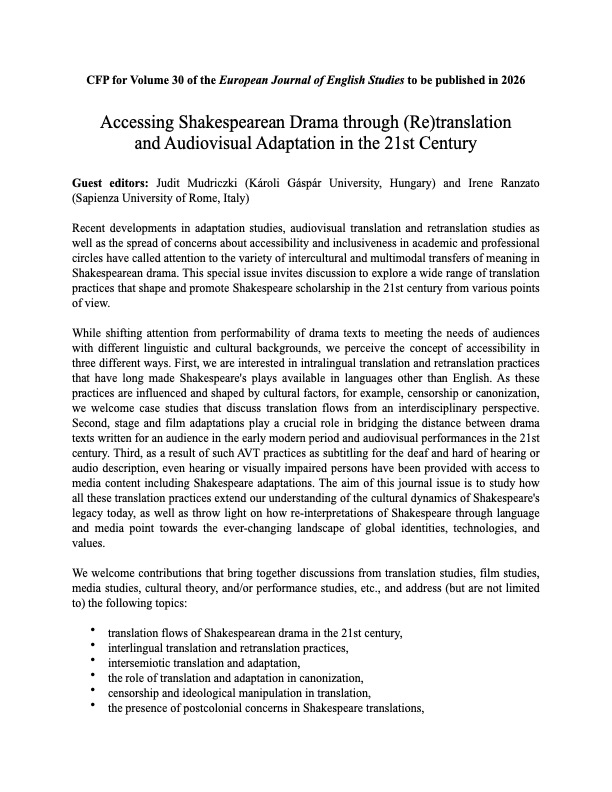Accessing Shakespearean Drama through (Re)translation and Audiovisual Adaptation in the 21st Century
Guest editors: Judit Mudriczki (Károli Gáspár University, Hungary) and Irene Ranzato (Sapienza University of Rome, Italy)
Recent developments in adaptation studies, audiovisual translation and retranslation studies as well as the spread of concerns about accessibility and inclusiveness in academic and professional circles have called attention to the variety of intercultural and multimodal transfers of meaning in Shakespearean drama. This special issue invites discussion to explore a wide range of translation practices that shape and promote Shakespeare scholarship in the 21st century from various points of view.
While shifting attention from performability of drama texts to meeting the needs of audiences with different linguistic and cultural backgrounds, we perceive the concept of accessibility in
three different ways. First, we are interested in intralingual translation and retranslation practices that have long made Shakespeare’s plays available in languages other than English. As these practices are influenced and shaped by cultural factors, for example, censorship or canonization, we welcome case studies that discuss translation flows from an interdisciplinary perspective. Second, stage and film adaptations play a crucial role in bridging the distance between drama texts written for an audience in the early modern period and audiovisual performances in the 21st century. Third, as a result of such AVT practices as subtitling for the deaf and hard of hearing or audio description, even hearing or visually impaired persons have been provided with access to media content including Shakespeare adaptations. The aim of this journal issue is to study how all these translation practices extend our understanding of the cultural dynamics of Shakespeare’s legacy today, as well as throw light on how re-interpretations of Shakespeare through language and media point towards the ever-changing landscape of global identities, technologies, and values.
We welcome contributions that bring together discussions from translation studies, film studies, media studies, cultural theory, and/or performance studies, etc., and address (but are not limited to) the following topics:
• translation flows of Shakespearean drama in the 21st century,
• interlingual translation and retranslation practices,
• intersemiotic translation and adaptation,
• the role of translation and adaptation in canonization,
• censorship and ideological manipulation in translation,
• the presence of postcolonial concerns in Shakespeare translations,
• inclusiveness and media accessibility of Shakespeare adaptations,
• audiovisual translation practices of screen adaptations,
• audio description and subtitling of Shakespeare on screen,
• surtitling Shakespeare performances.
Detailed proposals (up to 1,000 words) for full essays (approx. 7,500 words), as well as a short biography (max.100 words) should be sent to both editors by 20 April 2025: Judit Mudriczki (mudriczki.judit@kre.hu) and Irene Ranzato (irene.ranzato@uniroma1.it)
EJES operates in a two-stage review process.
1. Contributors are invited to submit proposals for essays on the topic in question by 20 April 2025.
2. Following review of the proposals by the editorial board panel, informed by external specialists as appropriate, the guest editors will invite the authors of short-listed proposals to submit full-length essays for review with a summer 2025 deadline.
3. The full-length essays undergo a second round of review, and a final selection for publication is made. Selected essays are revised and then resubmitted to the guest editors in late 2025 for publication in 2026.
EJES employs Chicago Style (T&F Chicago AD) and British English conventions for spelling.
For more information about EJES, see: http://www.essenglish.org/ejes.html and https://
[www.tandfonline.com/toc/neje20/current]www.tandfonline.com/toc/neje20/current


